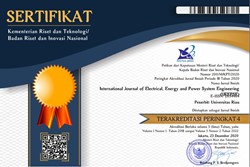Design of An Active Power Ankle-Foot Orthosis with Myoelectric Control for Drop-Foot Rehabilitation
Abstract
Drop-foot is an inability to lift the foot when walking due to muscle weakness or paralysis. One of the common rehabilitation aids for stroke sufferers with drop-foot is Ankle Foot Orthosis (AFO). This tool serves as a stabilizer for road pattern balance. However, most of the AFO used is passive, so it doesn't help users run properly. Therefore, an active AFO system has been designed as a rehabilitation aid. This AFO is designed with motor control from myoelectric feedback signal (EMG) and also a semi-dynamic ankle joint so that it is more flexible to help the user when stepping. The AFO movement set of to the foot's position in Dorsi and Plantarflexion conditions based on the EMG parameter received by the control unit. Then, the angle sensor standardizes the user's ankle position so that the foot fits the states that have set. This design uses the fuzzy logic method, which functions to control the rotation of the servo motor. The interface system is for monitoring parameters. In this design, pressure sensors (force), EMG, and angle sensors transmitted wirelessly to a computer are used for data analysis under the needs of real-time statistical data processing.
References
[1] Setiawan, R., Valentine, O. and Zakaria, H., “Design Therapy for Post-Stroke Patients with Robotics Tools and Principles of Mirror Neurons Using EEG Parameter Analysis”, In Proceedings of the 2nd International Conference on Control and Computer Vision, pp. 92-96, 2019.
[2] Bastian, Mansjoer, Kapita Selekta Kedokteran Jilid 2. Edisi ke-3, Jakarta: Media Aesculalpius FKUI, 2011.
[3] Zubaidi, “Penggunaan Posterior Leaf Spring Ankle Root Orthosis (PLS-AFO) Terhadap Perbaikan Pola Jalan dan Kecepatan Jalan Penderita Drop Foot AKibat Stroke di Klinik P&O Orthotech Boyolali, Jurnal Ilmu Kesehatan, 3(2), 2014.
[4] Wahyu, Genis Ginanjar, “Stroke: Hanya Menyerang Orang Tua”, Bentang-B First, 2009.
[5] Rokhana, R., “Identifikasi Sinyal Electromyograph (EMG) Pada Gerak Ekstensi-Fleksi Siku Dengan Metode Konvolusi Dan Jaringan Syaraf Tiruan”, In Industrial Electronic Seminar, 2009.
[6] Meor Zainol, W.S., “Analysis of electromyograph (emg) for controlling wheelchair motion”, Doctoral dissertation, Universiti Tun Hussein Onn Malaysia, 2015.
[7] Rachmat, N., Nugroho, A.S. and Syafii, M., “Pengaruh Penggunaan Afo Fleksibel Terhadap Keseimbangan Dinamis Pada Hemiparetic Cerebrovascular Accident (CVA)”, Jurnal Keterapian Fisik, 3(2), pp. 81-88, 2018.
[8] Jimenez-Fabian, R. and Verlinden, O., “Review of control algorithms for robotic ankle systems in lower-limb orthoses, prostheses, and exoskeletons”, Medical engineering & physics, 34(4), pp. 397-408, 2012.
[9] Adiputra, D., Ubaidillah, U., Mazlan, S.A., Zamzuri, H. and Rahman, M.A.A., “Fuzzy logic control for ankle-foot orthoses equipped with a magnetorheological brake”, Jurnal Teknologi, 78 (11), 2016.
[10] Gordon, K. E., Gregory, S. S., and Daniel, P. F, “Mechanical Performance of Artificial Pneumatic Muscles To Power An Ankle–Foot Orthosis”, Neural Networks, 39(10), 32-41, 2006.
[11] Sanchez-Valdes, D., Alvarez-Alvarez, A., and Trivino, G, “Walking Pattern Classification Using A Granular Linguistic Analysis”, Applied Soft Computing, pp. 100-113, 2015.
[12] Altas, I.H. and Neyens, J., “A fuzzy logic decision-maker and controller for reducing load frequency oscillations in multi-area power systems”, IEEE Power Engineering Society General Meeting, IEEE, 2006.
[13] Perry J. Gait, “analysis: Normal and pathological function”, Thorofare (NJ), SLACK, 1992.
[14] Crenna, P. and Frigo, C., “A motor programme for the initiation of forward‐oriented movements in humans”, The Journal of physiology, 437(1), pp. 635-653, 1991.
[15] Petrucci, M.N., MacKinnon, C.D. and Hsiao-Wecksler, E.T., “Modulation of anticipatory postural adjustments of gait using a portable powered ankle-foot orthosis”, 13th International Conference on Rehabilitation Robotics (ICORR), pp. 1-6, IEEE, 2013.
[16] Shorter, K.A., Kogler, G.F., Loth, E., Durfee, W.K. and Hsiao-Wecksler, E.T., “A portable powered ankle-foot orthosis for rehabilitation”, Journal of Rehabilitation Research & Development, 48(4), 2011.
[17] Rusdinar, A. and Kim, S.S., “Modeling of vision-based robot formation control using fuzzy logic controller and extended Kalman filter. International Journal of Fuzzy Logic and Intelligent Systems”, 12(3), pp. 238-244, 2012.
[18] Rizal, A, “Biomedical Instrumentation”, Graha Ilmu, Yogyakarta, 2014.
[19] Ferris, D.P., Gordon, K.E., Sawicki, G.S. and Peethambaran, A., “An improved powered ankle–foot orthosis using proportional myoelectric control”, Gait & posture, 23(4), pp. 425-428, 2006.



















